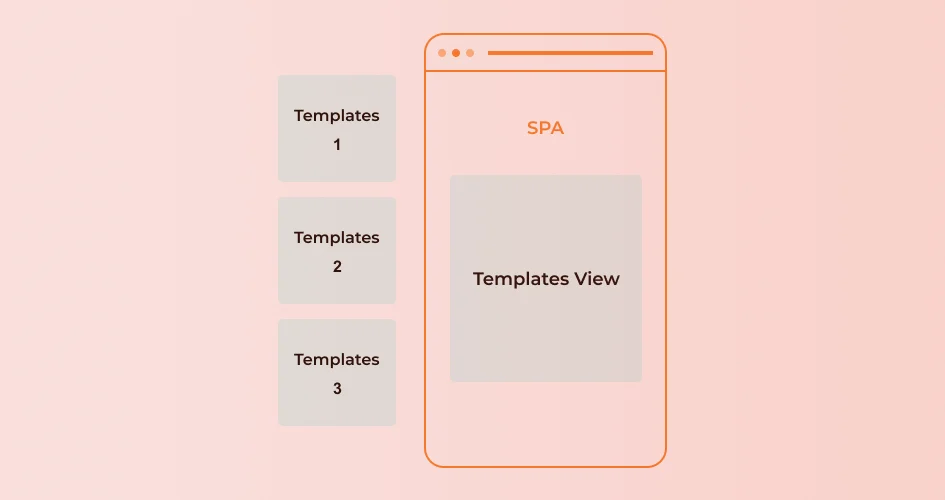A web application is software that runs in a browser, allowing users to access and interact with digital services without installation. Web apps operate on remote servers and function across different devices.
The main types of web applications include Content Management Systems (CMS), Progressive Web Applications (PWA), and Single-Page Applications (SPA). A CMS allows users to create, edit, and manage digital content without coding. A PWA combines website and mobile app features, offering offline access and fast loading. An SPA loads a single page and updates content dynamically without refreshing, improving user experience.
The most popular web application types are Progressive Web Applications (PWA) and Single-Page Applications (SPA). PWAs enable offline access and fast performance, while SPAs load a single page and update content dynamically.
What is a Web Application?
A web application is a software program that runs directly in a web browser. Unlike traditional desktop applications, it doesn’t require downloads or installations. It uses client-side scripts like HTML, JavaScript, and CSS, along with server-side scripts like PHP or ASP, to process user requests and return data.
Web applications handle various functions, from displaying content to managing user data. They are accessible from any device with an internet connection and are used for tasks ranging from blogs to e-commerce.
What are the Different Types of Web Applications?
Here are 11 categories of web applications, each with its unique features and use cases.
1. Static Web Applications
These are the simplest types of web applications built using HTML and CSS, suitable for creating portfolios or digital brochures.
As the name suggests, the content only changes if manually updated by the developer.
Static web applications are straightforward to create and host, as they don’t require extensive server-side processing.
This option is a cost-effective solution for individuals or small businesses needing a simple online presence.
However, their simplicity also means limited functionality.
2. Dynamic Web Applications
In contrast, dynamic web applications are more complex and interactive.
They use client-side and server-side scripts (like JavaScript, PHP, ASP, or JSP) to generate content in real-time.
These web application categories are connected to a database, allowing them to provide personalized experiences based on user interactions and preferences.
They’re ideal for businesses, especially if your top priorities are user engagement and content variability.
Due to their complexity, dynamic web applications are more challenging to develop and maintain.
They require a more robust hosting environment and higher web development costs.
3. Single-Page Applications (SPAs)
SPAs load a single HTML page and dynamically update content as users interact with the app.
These categories of web applications are ideal for platforms where user experience and speed are critical, such as:
- Social media platforms
- Email clients
- Cloud-based software
The benefit is that this web app type avoids reloading the entire page with each user action, leading to a smoother and faster user experience.
However, they also come with challenges, particularly in SEO optimization and initial load times, as the entire application must be loaded simultaneously.
SPAs are built using JavaScript frameworks like Angular, React, or Vue.js, which handle the dynamic loading of content and user interface elements.
4. Multi-Page Web Applications (MPAs)
Unlike SPAs, MPAs reload the entire page from the server when the user interacts with the application.
These traditional web application categories are more suitable to websites with a large amount of content and diverse functionalities, such as:
- eCommerce sites
- Online catalogs
- Educational platforms
MPAs can handle complex structures and vast databases more efficiently than SPAs.
They’re also better optimized for search engines, as each page can be indexed separately.
However, MPAs often have slower page transitions and can be more resource-intensive, as each new page needs a server request and page reload.
Developing MPAs typically involves a more extensive back-end process to manage multiple pages and their interactions with the server.
When considering developing these web application types, you can partner with a skilled website development company to ensure a seamless and effective online presence.
5. Progressive Web Applications (PWAs)
PWAs represent a hybrid of regular web pages (or websites) and a mobile application.
They’re installable on a device’s home screen without downloading from an app store.
A key feature of PWAs is the use of service workers or scripts running in the background, enabling:
- Offline functionality
- Push notifications
- Background data syncing
PWAs are also responsive and linkable, which can be shared via a URL.
They offer a high level of performance, engaging users with smooth animations and no janky scrolling.
Thus, these categories of web applications are incredibly efficient, especially for users with limited internet connectivity.
Developers use standard web technologies to build them, including HTML, CSS, and JavaScript.
6. Content Management Systems (CMS)
A CMS manages creation and modification of digital content, supporting multiple users in a collaborative environment.
CMS features vary widely, including but not limited to:
- Web-based publishing
- Format management
- History editing
- Version control
- Indexing
- Search
They’re suitable for blogging, e-commerce, and news websites, where you need to frequently update the content without extensive technical know-how.
CMS platforms like WordPress, Joomla, and Drupal are popular choices, offering templates and plugins for customization without needing to write code from scratch.
What’s more, CMSs provide a user-friendly interface, allowing for easy updates and managing content.
7. eCommerce Web Applications
These web application types facilitate online buying and selling.
They’re complex systems that integrate various functionalities, including:
- Product displays or catalogs
- Product search and filtering
- Shopping carts
- Payment processing
- Customer account and order management
- Customer service tools
E-commerce web applications must provide a seamless, user-friendly experience to encourage sales and repeat business.
These applications must be scalable to handle varying traffic and sales volume levels.
Also, security is paramount to protect sensitive customer data, including payment information.
Platforms like Shopify, Magento, and WooCommerce are famous examples, offering customizable templates and various plugins to enhance functionality.
E-commerce web applications have revolutionized the retail industry, allowing businesses to reach a wider audience and operate 24/7.
8. JavaScript-Powered Web Applications
JavaScript is a versatile programming language used to create dynamic and interactive web applications. According to Statista’s report titled “Most Used Programming Languages Among Developers Worldwide 2024,” published on February 6, 2025, by Lionel Sujay Vailshery, JavaScript was the most used programming language in 2023. JavaScript enables real-time updates, smooth animations, and enhanced user interactions, making it essential for modern web app development.
JavaScript can be used both on the client side (in the browser) and the server side (with technologies like Node.js), making it a powerful tool for full-stack development.
JavaScript-powered web applications are known for their speed and efficiency; they can update content without reloading the entire page.
This functionality makes them ideal for applications that require real-time data updates, such as:
- Social media platforms
- Online games
- Collaboration tools
Angular, and Vue.js are examples of JavaScript frameworks and libraries.
They provide pre-written JavaScript code to handle everyday tasks.
9. Rich Internet Web Applications (RIAs)
RIAs are advanced web application types that deliver a user experience like desktop applications.
They use client-side frameworks to provide interactive features and a richer user interface, such as:
- Adobe Flash
- JavaFX
- Microsoft Silverlight
RIAs run inside web browsers but behave like desktop applications, offering responsive, engaging user experiences with better data visualization and real-time interaction capabilities.
RIAs can process data and perform tasks without constantly communicating with the server, reducing load times and improving performance.
However, they require plugins or specific frameworks, which might limit accessibility and compatibility across different devices and browsers.
10. Portal Web Applications
Portal web applications are gateways to various information, services, and other applications.
Enterprises often use them for internal purposes or to provide customer-facing services, for example:
These web application types typically require user authentication, offering personalized content and a centralized access point to various resources.
Portal web applications are designed to aggregate content from different sources, providing a consistent and integrated user experience.
They can handle various functionalities, including:
- Search engines
- Email systems
- Forums
- Newsfeeds
11. Animated Web Applications
These applications focus on delivering rich visual content and interactive elements using animations.
They’re particularly popular in fields that need high levels of user engagement, such as:
- Online advertising
- Gaming
- Educational platforms
Animated web apps are built using technologies like CSS3, HTML5, and WebGL, so developers can create complex yet engaging user interfaces.
They provide dynamic and visually appealing experiences, capturing users’ attention and improving interaction.
However, developing these applications can be time-consuming and require advanced design as well as programming skills.
Furthermore, you need to balance the animations to enhance rather than hinder the user experience, especially considering performance and accessibility on various devices.
What are the Popular Examples of Web Applications?
The popular examples of web applications are Google Docs, Gmail, Facebook, Spotify Web Player, and Trello, which are widely used for productivity, communication, and entertainment.
- Google Docs – A Progressive Web Application (PWA) that enables real-time document editing, collaboration, and cloud storage without installation. It is the best type of web app for document management and team collaboration, providing seamless access from any device.
- Gmail – A Single-Page Application (SPA) that dynamically updates emails, allowing instant reading, composing, and organizing without page reloads. It is the best type of web app for email communication, ensuring fast performance and user convenience.
- Facebook – A Single-Page Application (SPA) that provides seamless social networking, messaging, and content sharing with real-time updates. It is the best type of web app for social interaction and user engagement, allowing smooth navigation between features.
- Spotify Web Player – A Progressive Web Application (PWA) that streams music directly in the browser, supporting offline playback and fast loading. It is the best type of web app for media streaming, ensuring uninterrupted access to content.
Trello – A Single-Page Application (SPA) that enables dynamic task management by instantly updating boards, lists, and cards without reloading the page. It is the best type of web app for project management, providing an intuitive interface for teams to track progress in real time.
What are the Benefits of Web Applications?
The benefits of web applications include accessibility, cost-effectiveness, scalability, multi-user access, and technology flexibility, making them essential for businesses and users seeking efficient digital solutions.
Benefit #1. Accessibility
Many types of web applications are accessible from any device with an internet connection, allowing businesses to reach customers anywhere.
This universal access is crucial for expanding market reach and ensuring consistent user experiences across various platforms.
Benefit #2. Cost-effectiveness
Web applications typically require less upfront investment compared to traditional software applications.
They’re less expensive to develop and deploy, as they don’t necessitate users to acquire additional hardware or software.
Also, the ongoing maintenance cost is lower because web applications require less manual updates and IT support.
Benefit #3. Scalability
Web applications can easily scale to accommodate a growing user base, which is essential for businesses anticipating future growth.
You can host the apps on cloud platforms, where you have the flexibility to adjust resources.
However, web applications come with their own set of challenges.
What are the Challenges of Web Applications for Businesses?
#1. Security
Security concerns are significant, as web application types are susceptible to online threats, such as unauthorized access, data breaches, and other cyber threats.
Businesses can implement robust security measures to protect their system by executing the following:
- Regular security audits and checks
- Data encryption
- Secure coding practices
- Authentication and authorization
- Input validation
- APIs security measures (keys, tokens, or OAuth)
#2. Performance Issues
Another shortcoming is the potential for performance issues.
Web applications can suffer from slow loading times and poor user experiences if not correctly designed or hosted on a powerful enough server.
#3. Online-only Used
Lastly, traditional web application types typically cannot be accessed offline, which can be a limitation in areas with unreliable internet connectivity.
For example, users traveling to or in a remote location will find accessing and using the web application difficult.
This dependency on internet access can also hinder the usability of web applications in certain situations.
When the internet connection drops or becomes unstable, users can lose their progress working on a task within the web application.
How Are Web Applications Different from Other Mobile Applications?
Web applications run in web browsers and do not require installation, while mobile applications are platform-specific and must be downloaded. Web applications use a single codebase for multiple devices, whereas mobile applications require separate versions for iOS and Android. Web applications depend on an internet connection for full functionality, while mobile applications can store data locally and access device-specific features such as GPS and cameras.
What Is the Difference Between a Web Application and a Website?
The main difference between a web application and a website is interactivity. A web application processes user input, manages data, and updates content dynamically, while a website primarily displays static or dynamically updated information. Web applications include Google Docs and Facebook, whereas websites include news portals and corporate pages.
How To Develop a Web Application?
To develop a web application, define the purpose, target users, and key features before starting development. Plan the technology stack, including front-end, back-end, and database solutions based on scalability and security needs. Design a user interface that ensures easy navigation and responsiveness across devices. Develop the front-end using HTML, CSS, and JavaScript and the back-end with frameworks like Node.js, Django, or Laravel to handle data processing and user authentication. Integrate a database such as MongoDB or PostgreSQL to store and retrieve data efficiently. Conduct thorough testing to identify performance, security, and usability issues before deployment. Launch the application on a hosting server and ensure ongoing web app development through regular updates, security patches, and feature improvements.
What Is the Cost of Developing a Web Application?
The cost of developing a web application starts at $5,000 to $10,000 USD for a basic version with minimal features. A medium-complexity web application ranges from $20,000 to $60,000 USD, while enterprise-level applications with advanced functionality exceed $100,000 USD. Additional costs include hosting, maintenance, security updates, and third-party API integrations.
What Programming Languages Are Used to Develop Web Applications?
Programming languages used to develop web applications include HTML, CSS, and JavaScript for front-end development. Back-end development uses Python, PHP, Node.js, and Java to process data and manage server-side operations. Database management relies on SQL and NoSQL to store, retrieve, and organize data efficiently.
What Frameworks Are Used to Develop Web Applications?
Web applications are built using front-end and back-end frameworks to streamline development and enhance performance. Front-end frameworks include React, Angular, and Vue.js, while back-end frameworks include Node.js, Django, and Laravel. Database management uses MongoDB and PostgreSQL, while full-stack frameworks such as Meteor.js integrate both client-side and server-side functionality.





